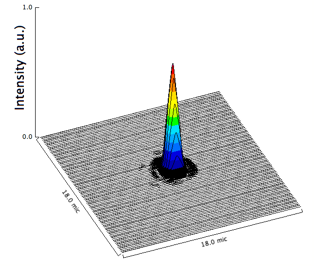Laser Technology Development
CUOS researchers are currently undergoing a number of projects researching laser development technology, to enable higher intensities, shorter pulses and cleaner pulses in the future.
Ultrahigh Intensities
The HERCULES laser produces world-record intensities ~ 1022 W/cm2. Clearly, it is very difficult to measure such intensity directly. We developed a method to do so based on wavefront measurement and calculation of the focal spot distribution [1]. The validity of the method is checked at low intensity by direct measurement of the focal spot distribution with a camera. A combination of the wavefront sensor and adaptive optics allows us to compensate all aberration in the laser system and aberrations of the very fast parabolic mirror and achieve a diffraction limited spot size of the order of the laser wavelength (Fig. 1). Of course, the Raleigh range is also of the order of laser wavelength. In this case only targets with a very sharp interface can be illuminated at extreme intensities. If the initially sharp (solid) target is subjected to a sufficiently high laser noise preceding the main pulse then this noise may ablate the target and create a preformed plasma. This preformed plasma may expand to the distance much greater than the Raleigh range thus substantially reducing intensity of the main pulse on the surface of the target. We achieved the highest intensity contrast of 1011 relative to amplified spontaneous emission lasting a few nanoseconds [2]. However there is still some noise on the time scale less than 100 picoseconds before the main pulse which we plan to eliminate in the future.

The underlying reason why we are interested in intensities ~ 1022 W/cm2 and higher is the exotic physics that is expected at these ultrahigh intensities. First of all, at such intensities an electron is accelerated so violently that its own radiation starts to affect electron motion in the laser field. At intensity of 1025 W/cm2 the quantum nature of the electron radiation has to be accounted for. Practically, a very efficient laser-driven source of hard X-rays and gamma-rays is feasible. Secondly, in addition to electrons, ions become relativistic at 1024 W/cm2 creating a fully relativistic plasma that can exist naturally only in astrophysical events.
Fig.1. Focal spot characterization – intensity distribution in the focal spot of parabolic mirror calculated for the corrected wavefront showing spot diameter d=1.3 microns (FWHM).
References:
1. S.-W. Bahk, P. Rousseau, T. Planchon, V. Chvykov, G. Kalintchenko, A. Maksimchuk, G. Mourou, V. Yanovsky, “The generation and characterization of the highest laser intensity (1022W/cm2),” Opt. Lett. 29, 2837-2839 (2004).
2. V. Chvykov, P. Rousseau, S. Reed, G. Kalinchenko, and V. Yanovsky, “Generation of 1011 contrast 50 TW laser pulses,” Opt. Lett. 31, 1456-1458 (2006).
 MENU
MENU